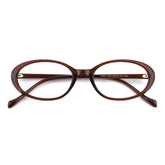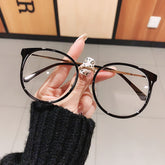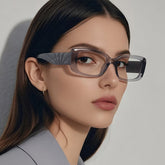What are color blind glasses?
A normal human eye sees three colors: red, green, and blue. All other colors are the result of a mixture of varying amounts of red, green, and blue. When a person has Color Vision Deficiency, one or more of the three primary colors is not detected correctly. The lack of information received due to color blindness slows down or prevents comprehension. The lack of comprehension creates a slower reaction time to the information and generally lowers a person's quality of life. While there is no cure for color blindness, color-blind glasses have emerged as a tool to enhance color perception for those with CVD.
- What causes color blindness?
- What are the common types of color blindness?
- How do color-blind glasses work?
- Do color-blind glasses really work?
- Can you wear color-blind glasses all the time?
What causes color blindness?
Color blindness is largely hereditary, which means you were born with color blindness. If you have other underlying diseases that affect the optic nerve, retina, brain, or nervous system, you may also develop certain types of color blindness in your future life.
In most cases, people with color vision defects will not see a world without black and white tones. Contrary to common belief, people with color blindness can still see colors, but the colors they see are different from tricolor vision.
Red-green color blindness is the most common type of color blindness, which affects your perception of colors and tones containing elements of red or green light. There are also some rare color vision defects, which are genetic visual impairments that exist at birth and limit your vision to black, white, and gray shadows—a world without color.
What are the common types of color blindness?
- Protanopia (Red-blindness): Difficulty seeing red hues.
- Deuteranopia (Green-blindness): Difficulty seeing green hues.
- Tritanopia (Blue-blindness): Rare; difficulty distinguishing blue and yellow.
Most color-blind glasses are designed for “red-green color blindness”, which is the most common form.
How do color-blind glasses work?
Color-blind glasses use specially designed lenses with optical filters that selectively block certain wavelengths of light. This helps the wearer differentiate between colors that would otherwise appear similar. Advanced lens technology to enhance color vibrancy and contrast. Approximately 80% of those with red-green color blindness will see some improvement in their ability to distinguish colors.
Do color-blind glasses really work?
When you wear color-blind glasses, you are not correcting the missing cells in your eyes. It's like putting a specialized filter in front of your line of sight to help illuminate some shadows. You can imagine color-blind glasses as contrast glasses. If you have slight or moderate color vision defects, they may help you determine differences in color or tone brightness, but they will not display new colors.
For example, if you have a red-green visual impairment, color-blind glasses only enhance the contrast between colors in order to distinguish their differences from each other. That is to say, everything you see may be a color tone, except that red may look more pink, while brown may look darker. Colorblind eyes do not alter a person's genetics or health and therefore cannot solve underlying diseases.
While they don’t "cure" color blindness, many users report significant improvements in color distinction. The effectiveness depends on:
- The type and severity of color blindness
- Lighting conditions
- Individual differences in perception
Some people will experience the effect immediately, while others may need time to adapt.
Can you wear color-blind glasses all the time?
By blocking some light to reduce color overlap, the effect of color blind glasses can be achieved. But this also makes it harder to see at night or in low light. Therefore, you shouldn’t wear color-blind glasses at night or while driving because these glasses limit the amount of light that makes contact with your retina and can cause problems with vision and reaction time.
Moreover, color-blind glasses and their ability to contrast differences in color are only effective as long as you’re actively wearing them. That means your color vision deficiency won’t improve over time the more you wear these glasses.
In general, color-blind glasses are a groundbreaking innovation that can dramatically improve color perception for many individuals. If you or someone you know has color vision deficiency, trying a pair could be a life-changing experience!











